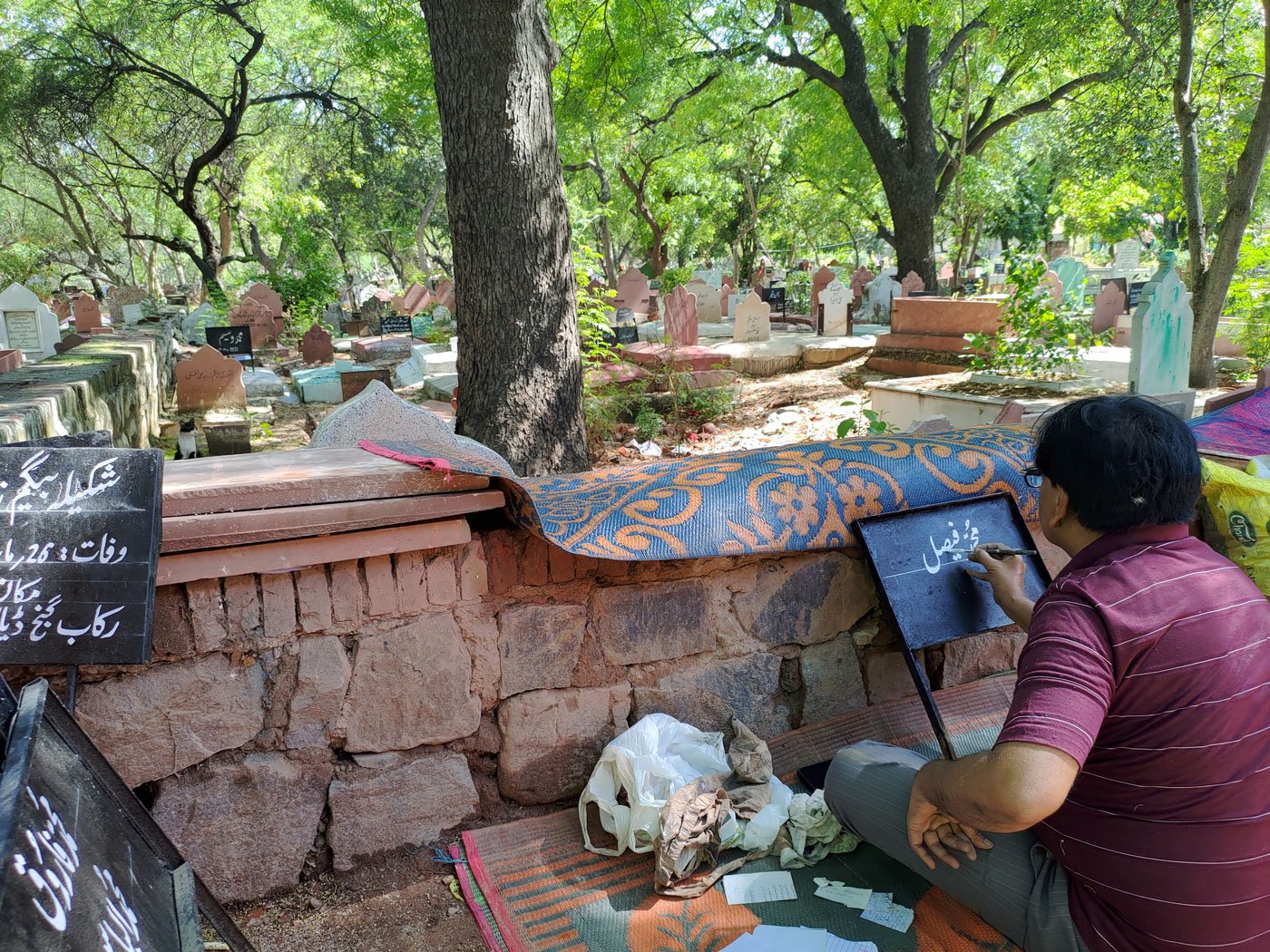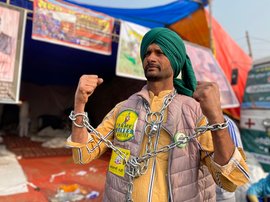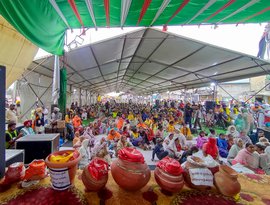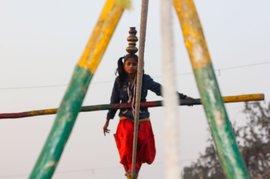“Every soul will taste death,” reads the inscription. Not so much in prophecy as in epitaphs on most of the gravestones in one of New Delhi’s largest cemeteries, the Jadeed Ahl-e-Islam Qabristan.
The line — كُلُّ نَفْسٍ ذَائِقَةُ الْمَوْتِ – is from a Quranic verse and adds serenity and sombreness to the gloom of this predominantly Muslim graveyard. An ambulance drives in with another dead person whose dear ones offer last prayers for the departed. Soon the van is empty, and a grave occupied. A machine then fills the grave with earth.
In a remote corner of this cemetery — located adjacent to the buildings housing media companies at Bahadur Shah Zafar Marg — sits Nizam Akhtar, 62, writing the names of the deceased on the gravestones —
mehrab
as he calls them. With his
parkaza
(calligraphy brush) held delicately between his fingers, he strokes a
nuqta
—
a dot on certain letters of Urdu that give them their particular pronunciation. And the word he is writing is ‘Durdana’ – the name of a victim of Covid-19.
Nizam is actually painting the names and accompanying text on the gravestones in fine and complex calligraphy. Later a co-worker will use a hammer and chisel to engrave the text exactly along his inscription – the paint disappearing when he does that.
Nizam the
katib
(scribe or calligrapher) has been printing names of the deceased on gravestones for over 40 years now. “I cannot remember the total number of gravestones I have worked on,” he says. “This April and May, I wrote about 150 names of people who had died of Covid, and the same number of non-Covid ones. Each day, I complete three to five stones. It takes about an hour to write on one side of a stone,” he says. That is, in Urdu. On the other side, usually, just the name of the departed appears in English. “It is not like filling a page in seconds,” he smiles, gently mocking my notetaking.
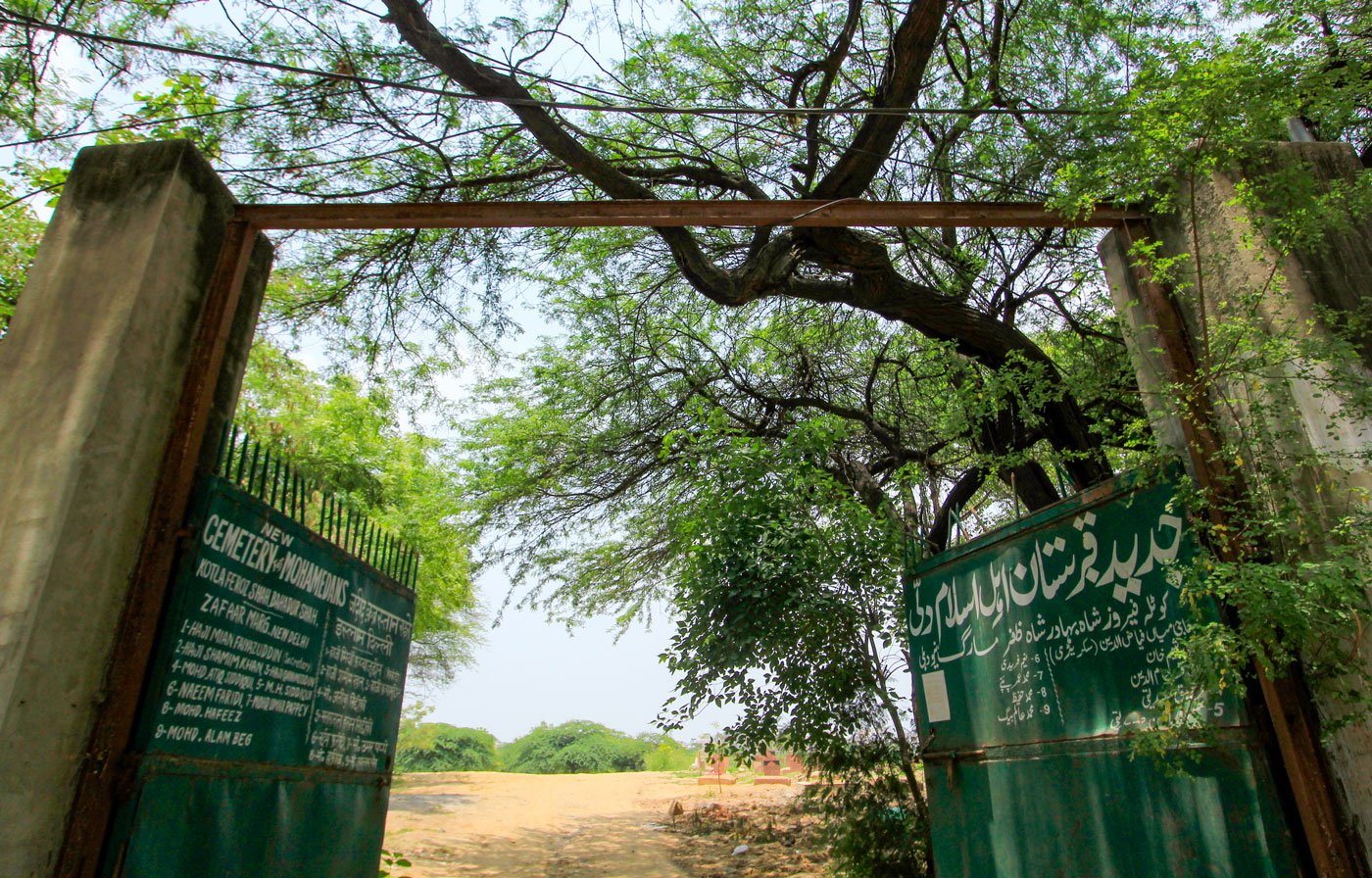
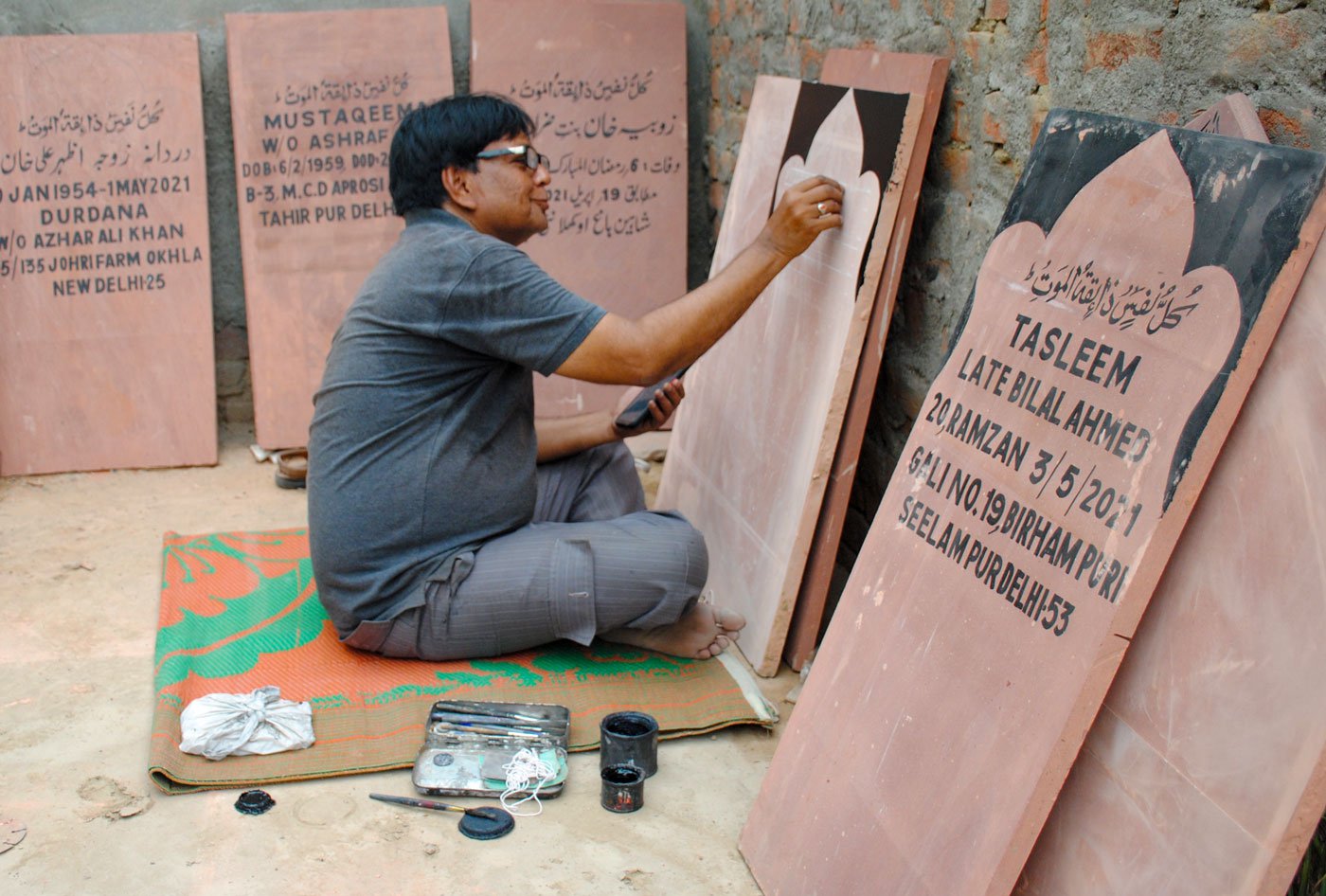
Left: One of the gates to the qabristan; on this side only those who died of Covid are buried. Right: Nizam Akhtar writing the names of the deceased on gravestones
Against the usual one or two commissions for gravestone inscriptions that the Jadeed received each day before the onset of the pandemic, it now gets four to five daily, increasing the workload by over 200 per cent. That load will be shared by four workers. As of this week, they are not taking any fresh orders. As many as 120 half-finished gravestones and 50 they are yet to begin working on, are on their hands.
It’s a booming business – but one whose rapid growth breaks the hearts of its practitioners. “Too many humans have died,” says Mohammad Shamim, a third-generation worker at this graveyard. “And humanity too, with them. My heart cries for hours, witnessing the scenes of death.”
“The truth of life – people who have come on this earth, live – is similar to the ultimate truth of death — all shall depart,” says Nizam. “People keep going away and I keep getting gravestones,” he says, like a philosopher of death. “But I had never seen anything like this ever before.”
This rush in the trade comes despite the fact that not every family commissions a gravestone. Some who cannot afford them just use iron boards with text painted on them that cost much less. Many graves go unmarked. “And some commissions for gravestones come 15 to 45 days after the burial,” Nizam says. “Every order that we take, the family has to wait for at least 20 days,” says his co-worker Asim (name changed on request), a stone carver from Ballabgarh in Haryana’s Faridabad district.
Unlike last year, when he was a sceptic, 35-year-old Asim, now believes in the existence of the coronavirus. “The bodies do not lie. I saw so many of them, which left me with no option but to believe it.” People have even dug graves for their family members on their own. “Sometimes there are not enough grave diggers,” he says.
“Earlier, before the pandemic began, this graveyard routinely received about four to five bodies each day. About 150 a month,” a caretaker from the committee running the graveyard told us.
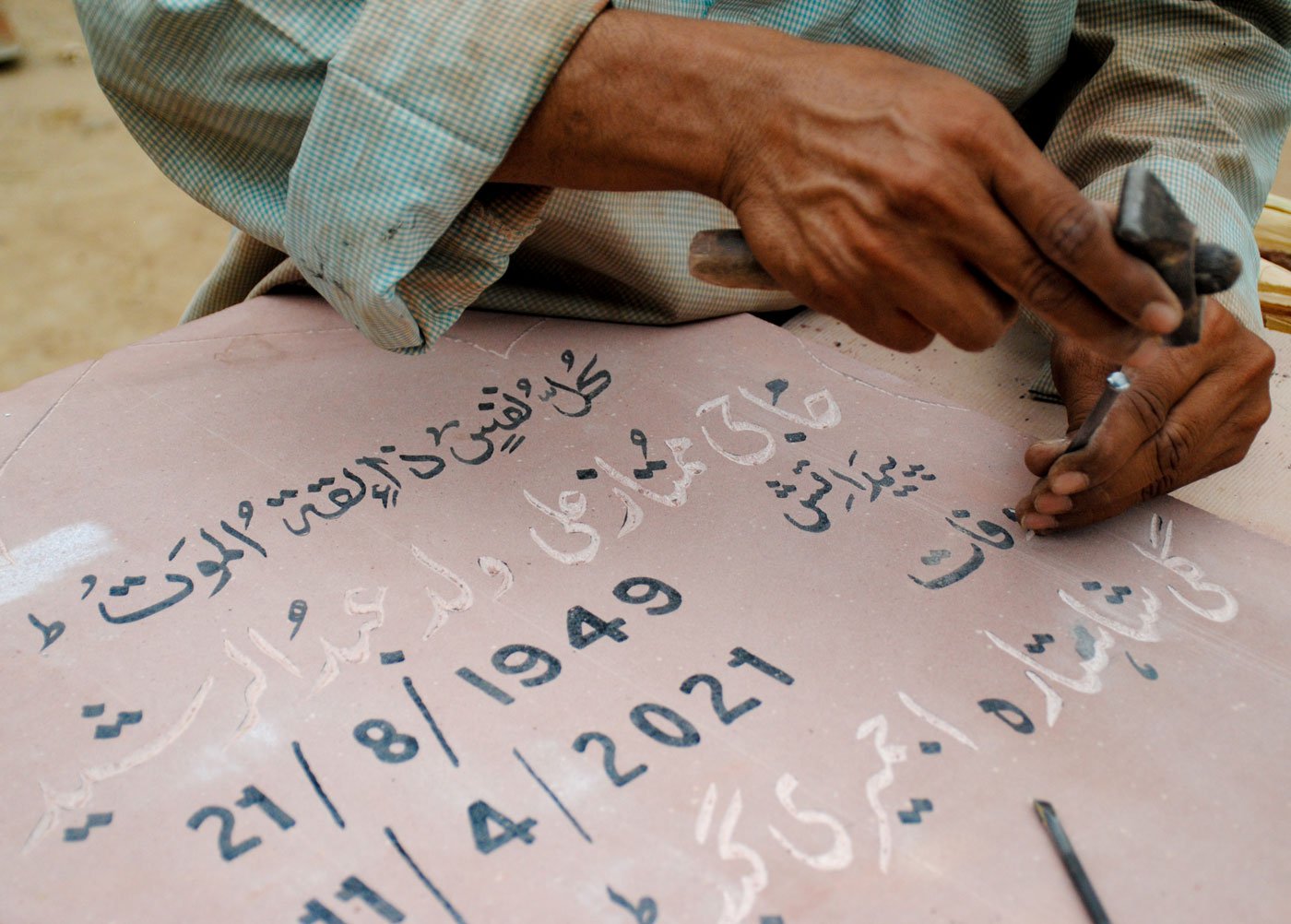
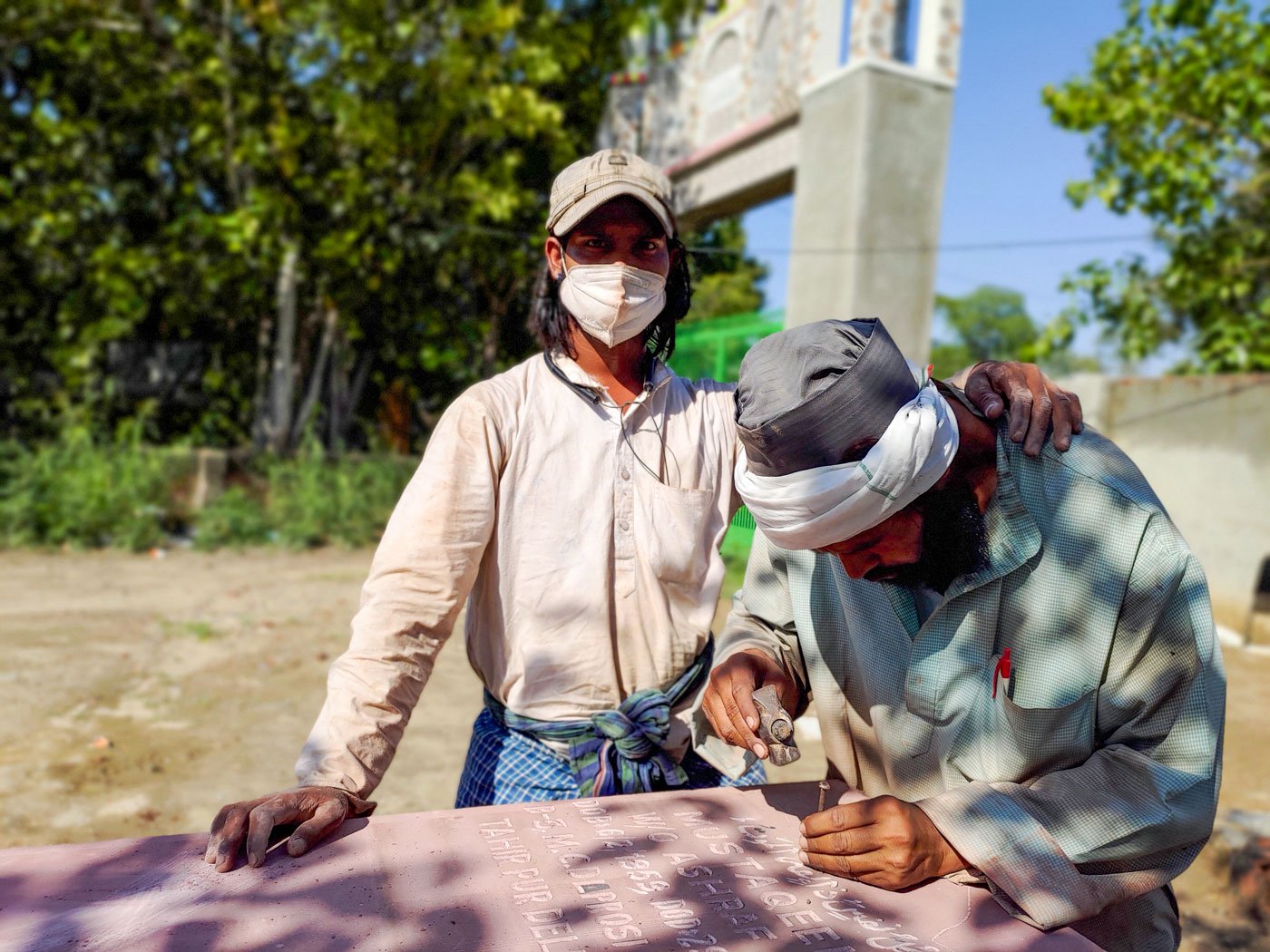
Asim and Aas (left to right) engraving the mehrab : 'Every order that we take, the family has to wait for at least 20 days'
In just the two months of April and May this year, it received 1,068 bodies – of which 453 were of Covid-19 victims and 615 of others. Well, that’s the official figure of the graveyard, anyway. Workers here – not wanting to be named – say the numbers are perhaps 50 per cent higher.
“One woman came to the graveyard along with her one-and-a-half-year-old baby,” says Asim. “Her husband, a migrant from some other state, had died of Covid-19. She had no one here. We arranged his burial. The baby was pouring soil in his father’s grave.” As an old proverb goes: if a baby dies, she is buried in her parents’ heart. Is there a proverb on what happens when a baby helps bury its parents?
Asim and his family were also hit by Covid-19. He, his two wives, and his parents, suffered all its symptoms. Their five children remained safe. None in the family ever went for a test – but all survived. “I break stones here to run my family,” he says of the slabs he carves. Asim – who earns Rs. 9,000 a month at Jadeed – has also led the Namaz-e-Janaza (final prayers) for hundreds of deceased, both Covid victims and others.
“My family encourages me to work here, as those offering services to human beings on their last journey will be rewarded in the world hereafter,” Asim says. Nizam, whose family also supported his coming here, holds the same belief. Both were afraid of the job initially, but soon left behind their fears. “When there is a body lying on the ground, you do not think of your fear but about the burial,” says Asim.
The charge for a completed gravestone at the Jadeed qabristan is Rs. 1,500. Of this, Nizam gets about Rs. 250 to 300 for his calligraphy known as kitaabat . Each slab of stone he works on is about 6 feet long and 3 feet wide. From this, four gravestones – each 3 feet long and 1.5 feet wide – are cut. Every stone is then given a dome-shape at the top. The finished product is what is known as a mehrab . Some people use a bit of marble as well. Those who use iron boards instead of stones spend just Rs. 250 to 300, about a sixth of what the full mehrab costs.
For every order they accept, Nizam asks a family member to neatly write out on paper all the details required. That includes the name of the deceased, either the husband or father’s name (in case of a woman), dates of birth and death, and address. Additionally, any Quranic verse that the family wants inscribed. “It serves two purposes. One, the relative gets to write the name of the deceased and two, it helps avoid any mistakes,” Nizam tells me. Sometimes, the text may also consist of an Urdu couplet like the following, which will be written on the gravestone of Jahan Ara Hasan, whose family has just made their order.
Abr-e-Rehmat unki marqad par guhar-baari kare
Hashr tak Shaan-e-Karimi Naaz Bardaari kare.
May the cloud of blessings pour pearls on her tomb,
and she remain a cosseted being forever.
Nizam began practising
kitaabat
in 1975. After his father, himself a painter, died in 1979, Nizam began writing on gravestones. “Though my father was an artist, I did not learn from him. I just watched him painting. And I was naturally blessed with this beautiful gift,” he adds.
In 1980, he graduated in Urdu from Kirori Mal College of Delhi University. He pursued this line of work and opened a shop in front of the now permanently closed Jagat Cinema — a single screen movie theatre — that once showed historical films such as
Pakeezah
and
Mughal-e-Azam
. Nizam married Naseem Ara in 1986. The expert calligrapher has never written his wife a single letter. He didn’t need to. “She would go to her parents and come back, as she lived in the same neighbourhood. The couple has a son and a daughter and six grandchildren. They live near the Jama Masjid in Old Delhi.
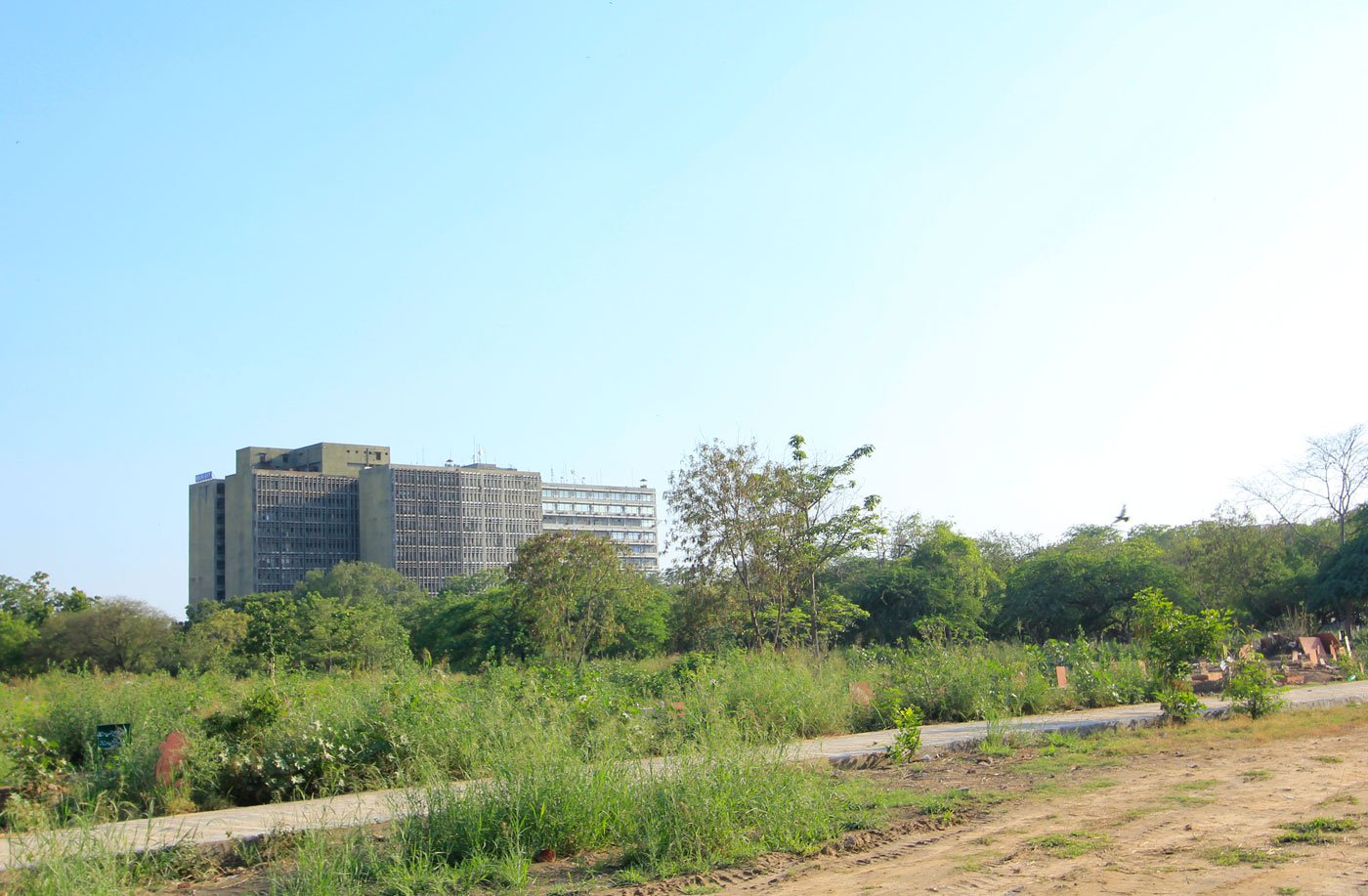
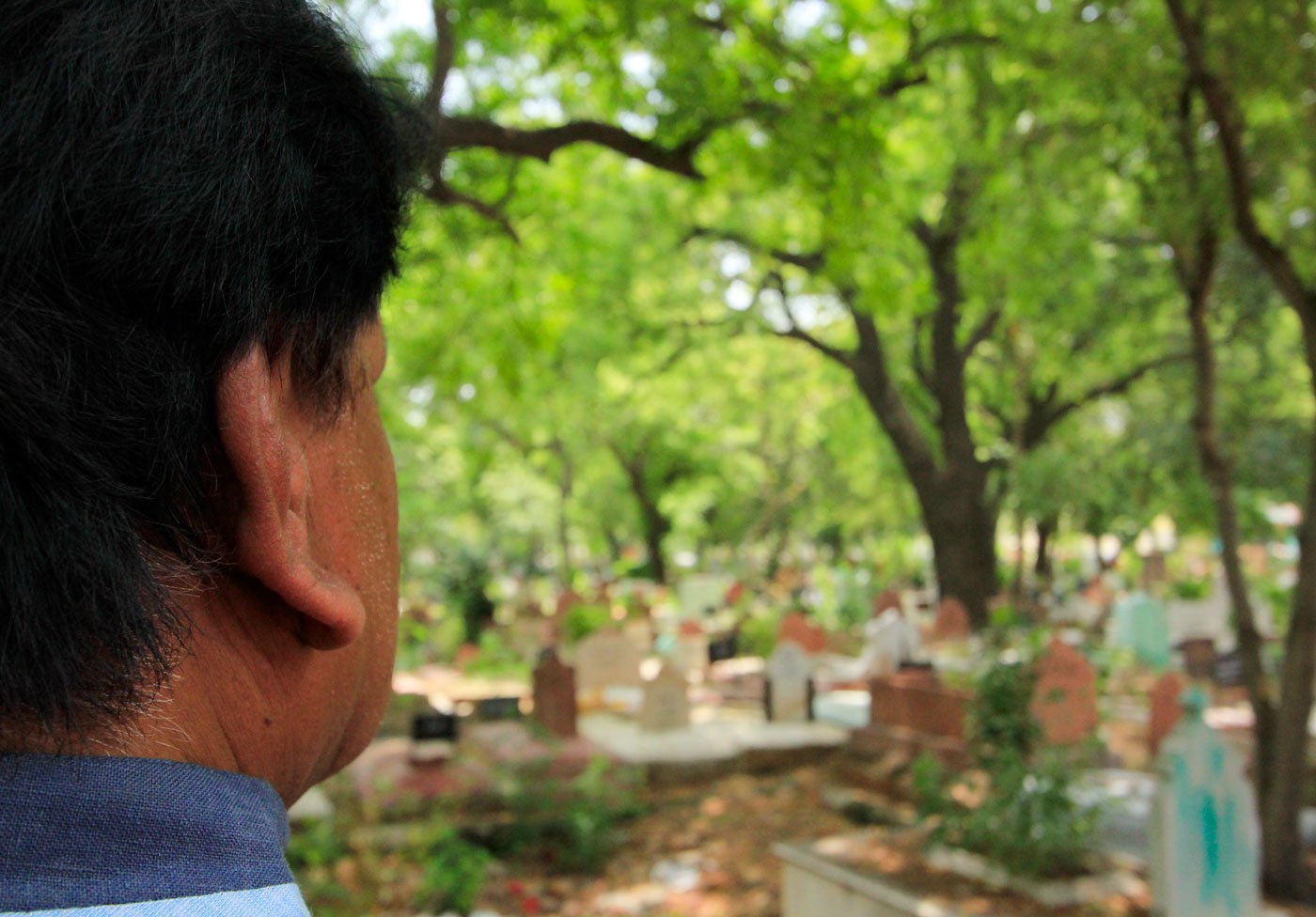
Left: From across the graveyard, you can see the building of the Delhi police headquarters at ITO. Right: Nizam has been printing names of the deceased on these gravestones for over 40 years
“Back then, I would paint hoardings for
mushairas
[gatherings for recitations of Urdu poetry], conferences, commercial advertisements, seminars, religious and political meetings.” He also took orders for
mehrab
painting in his shop. There was, too, a lot of protest material, banners, hoardings, and placards made at the shop.
The then prime minister of India, Rajiv Gandhi, he says, had allowed opening of the locks on the Babri Masjid in the mid-80s. “It led to massive protests from the Muslim community and others. I would paint the agitation banners on cloth, and posters calling for protests. After Babri was demolished in 1992, the agitations died a slow death,” Nizam says. “There was anger [against the demolition] in people but now they hardly came out.” Generally too, in society, political activity requiring that kind of work subsided, he observes. “I employed as many as eight workers. All of them had to leave gradually. I had no money to give them. Not knowing their whereabouts hurts me,” he adds.
“During 2009-10, due to a throat infection, I lost my voice and could only regain half of it after about 18 months. It is enough for you to understand me,” he
laughs. The same year Nizam’s shop shut down. “But never did I stop writing names on the
mehrab
.”
“Then, as Covid-19 arrived in India, the workers in this graveyard needed my services and I could not deny them. I came here in June last year. This is also because I had to run my family.” Nizam’s son runs a small footwear shop near the Jama Masjid. But the pandemic and lockdowns have affected his income severely.
Like the Jagat Cinema that closed down in 2004, all that surrounds Nizam’s old workspace now are memories. He loves Sahir Ludhianvi’s writings, and listens to his lyrics. The great poet died the very year Nizam graduated. His favourite Ludhianvi line: ‘Come. Let us, once again, become strangers to each other.’ In other words, life and death have never been on speaking terms.
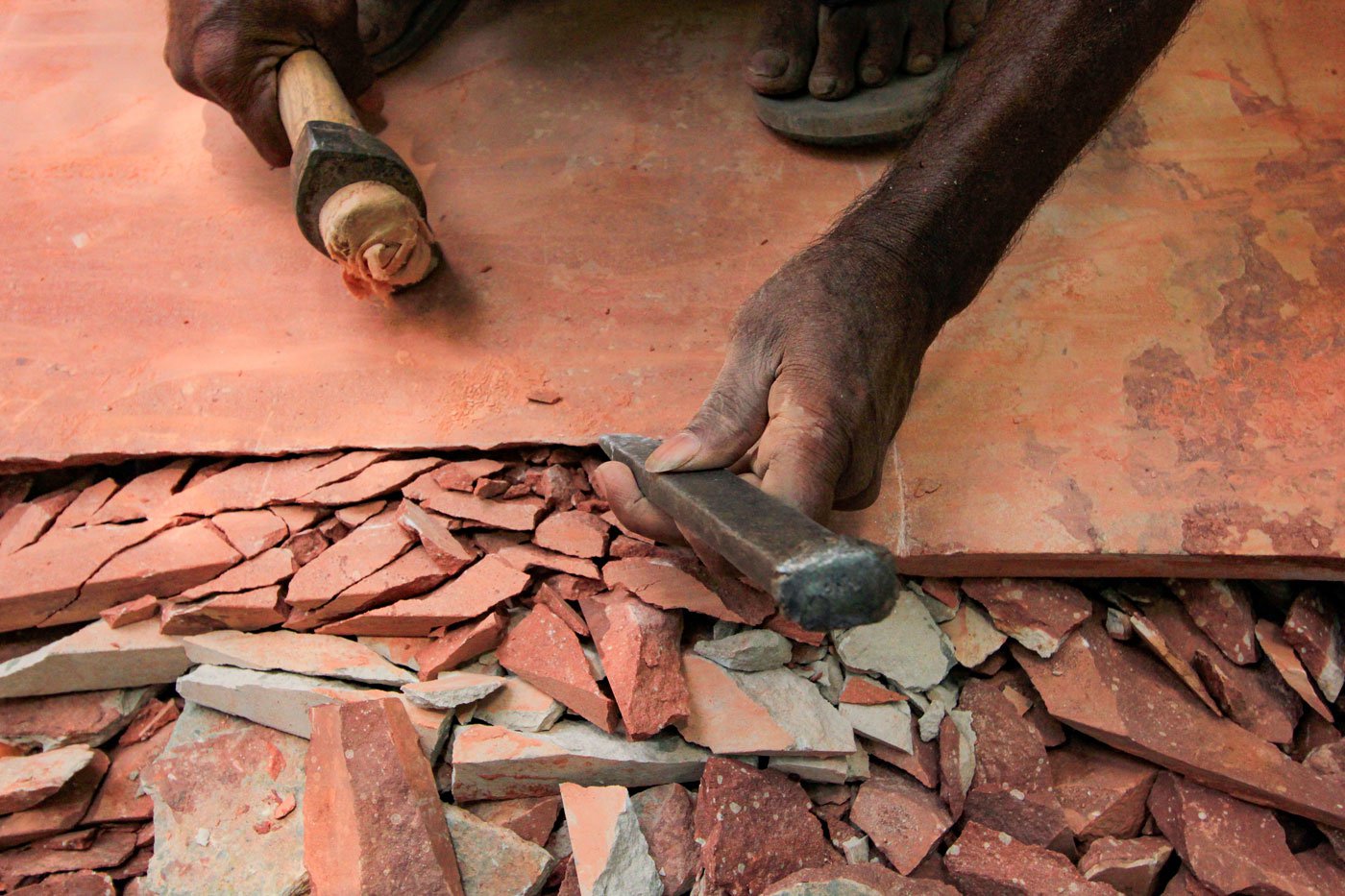
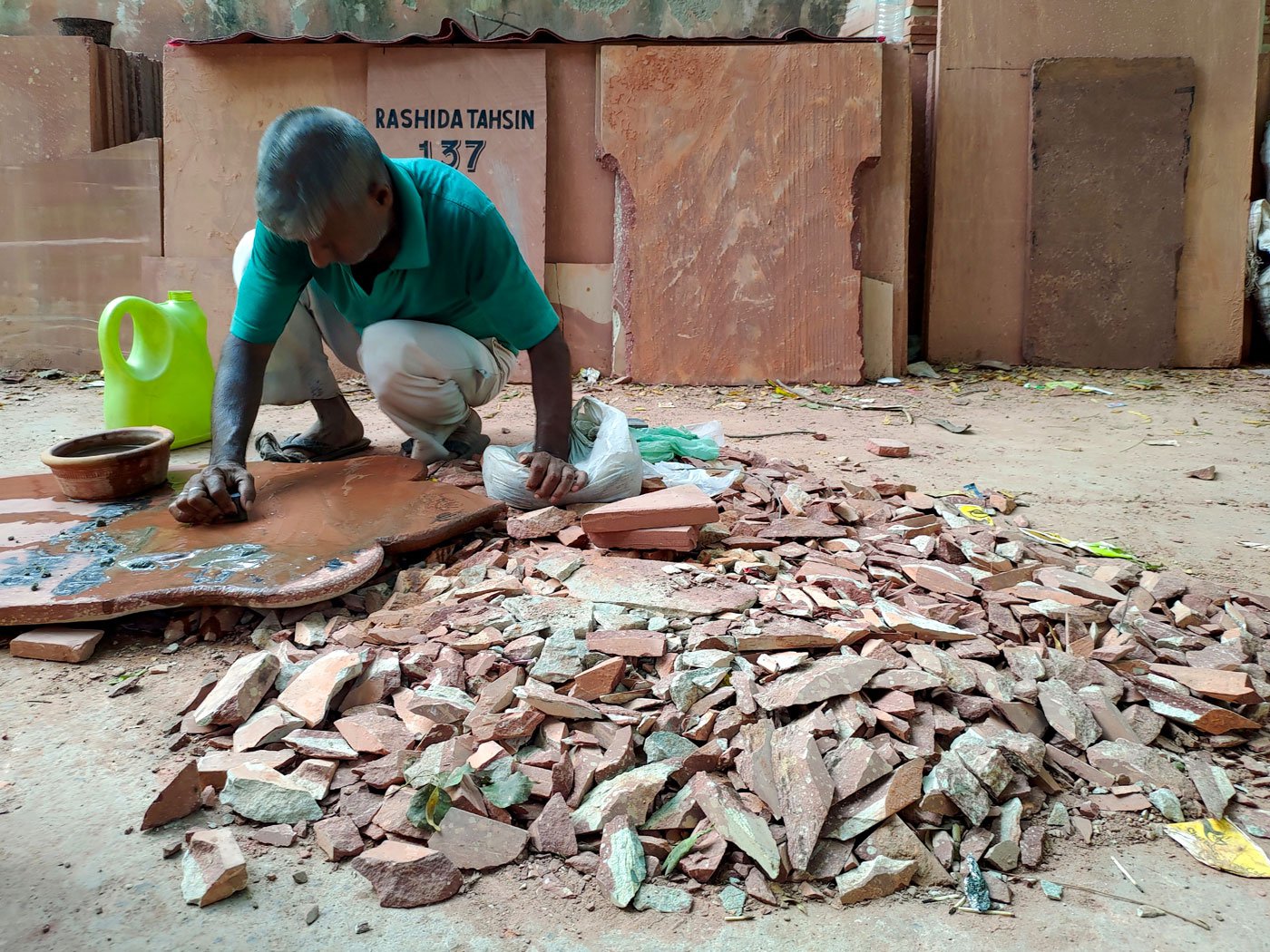
Nandkishore, an expert in cutting stones and shaping them with hammer and chisel, says, 'The graveyard has never seen such a horrible situation as it does now'
“In those days, there were artists who could write in Urdu. Now there are people who can write on gravestones in Hindi and English. It is rare to find someone in Delhi who can write names on
mehrab
in Urdu,” he says. “The language has been damaged and dented by politics, by a created myth that it is a language of Muslims alone. Careers in Urdu calligraphy are far fewer today than they used to be.”
After Nizam finishes the
kitaabat
on a
mehrab
he is working on, the paint dries for a while before the workers – Asim, Suleiman and Nandkishore – engrave it. Nandkishore, in his 50s, has been working at the graveyard for over 30 years. He is an expert in cutting stones and giving them that dome-shape with his hammer and chisel – without once using a machine. “The graveyard,” he says, “has never seen such a horrible situation as it does now.”
Nandkishore does not carve gravestones for the Covid-dead. He sits at another corner of the qabristan complex hoping this will protect him from the virus. “I get 500 rupees for one stone that I carve, cut, wash and complete each day,” he says. “Ye angrezon ke zamaane ka qabristan hai [This is a British period graveyard],” he adds. And laughs when I ask if that isn’t all that the British left us – graveyards?
“A Nandkishore working in a Muslim graveyard is, at times, a surprise for some. All I do in such situations is look at their faces and smile, not knowing what to say. However, sometimes I do tell them: ‘I engrave Quranic verses for you, something you have never done in your life, despite being Muslims.’ Then they thank me, trust me, and I feel at home,” says Nandkishore, a father of three children, who lives in North Delhi’s Sadar Bazar.
“These people lying inside their graves are like my own. Once I step outside, the world does not belong to me. Here I am at peace,” he says.
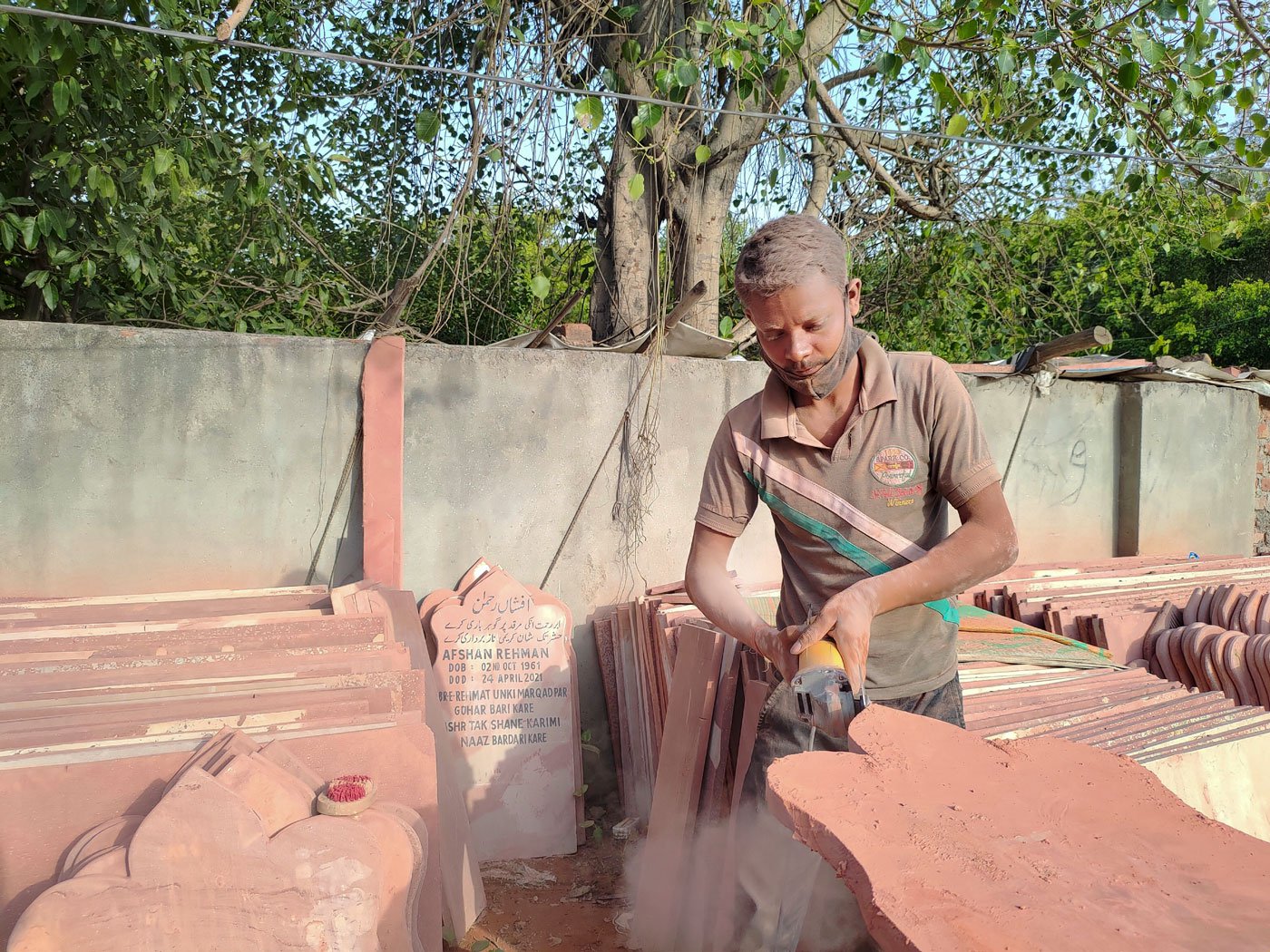

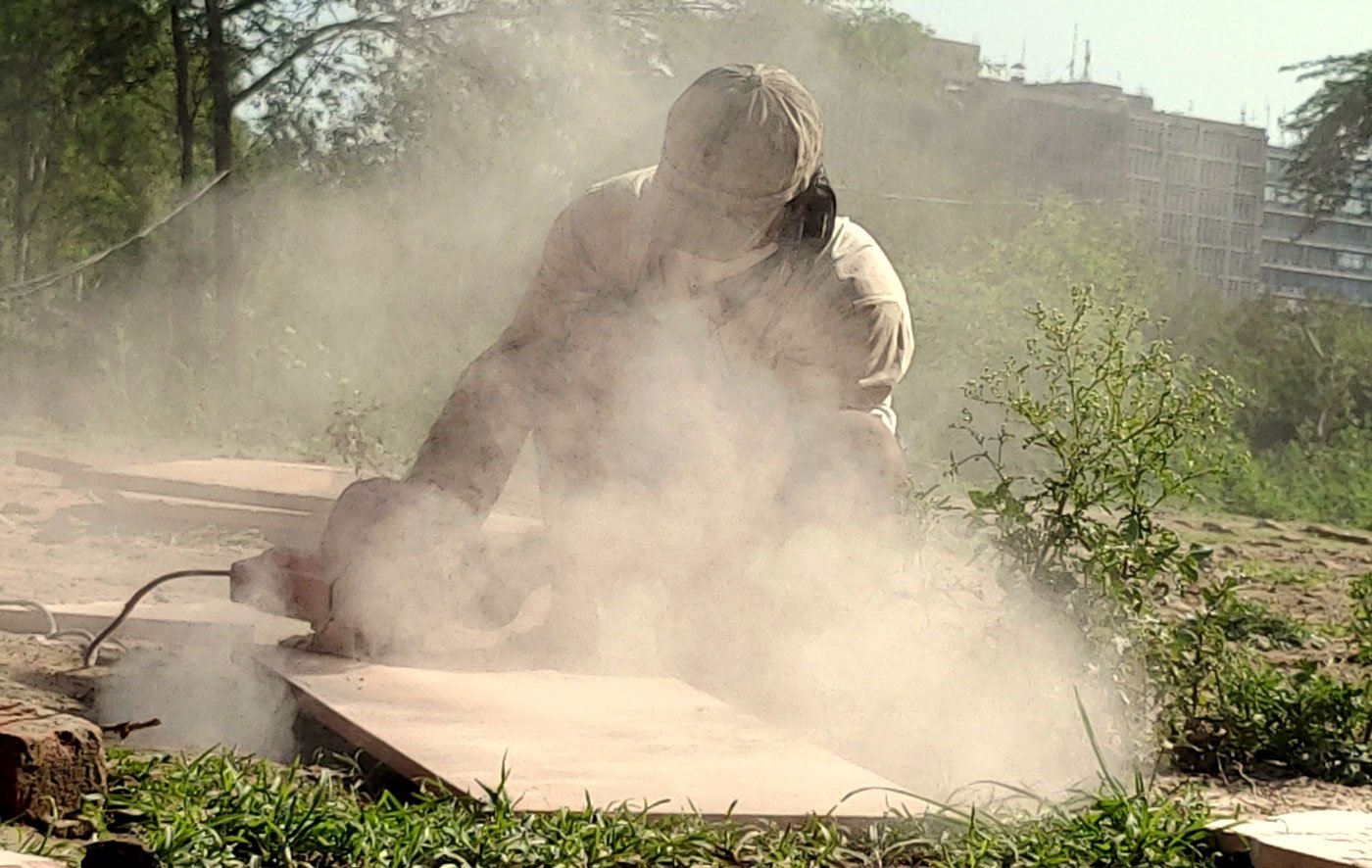
Pawan Kumar and Aas Mohammad: the dust from the stone work often covers them entirely
A new worker was hired two months ago. Pawan Kumar, from Bihar’s Begusarai district. He his wife and three children are back in Bihar. Pawan, 31, also cuts stone. “My face has become red,” he says after cutting 20 slabs with the help of a small stone cutter machine. The dust from his work has spread all over his body. “Covid or no Covid, I have to work throughout the year to feed my family. Here, I can get up 700 rupees a day sometimes.” He had no steady employment earlier, and, like Nandkishore and Shamim, has never had the benefit of a formal education.
Another labourer, Aas Mohammad, 27, from Aligarh town in Uttar Pradesh, is an all-rounder partaking in every one of the graveyard’s operations. He has worked here for about six years now. Aas’ family had fixed his marriage with a distant relative’s daughter in Uttar Pradesh’s Kasganj district.
“I had fallen in love with her. She died of Covid-19 during the lockdown last year,” he says. His family then arranged another match. “This girl, in March this year, rejected the proposal because she did not want to marry a man working in a graveyard.
“In grief, I started working more. Digging more graves, cutting more stones. And I do not want to marry now,” says Aas. He is cutting slabs as he speaks. He too is covered with dust from head to toe. He gets Rs. 8,000 a month.
Nearby, a yellow butterfly flits around the graves, as if uncertain whether to kiss the flowers kept on them or the tombstones.
Nizam, the epitaph writer says: “Those who die, die. With Allah's help, I am the one who gives them their name for the last time. That here was someone, somebody’s loved one.” His brushes, draped in white and black paint around their tips, move on the
mehrab
the way Nizam wants them to. He strokes a
nuqta
on the last letter of the last word as he writes in Arabic: ‘Every soul will taste death’ on yet another stone.
